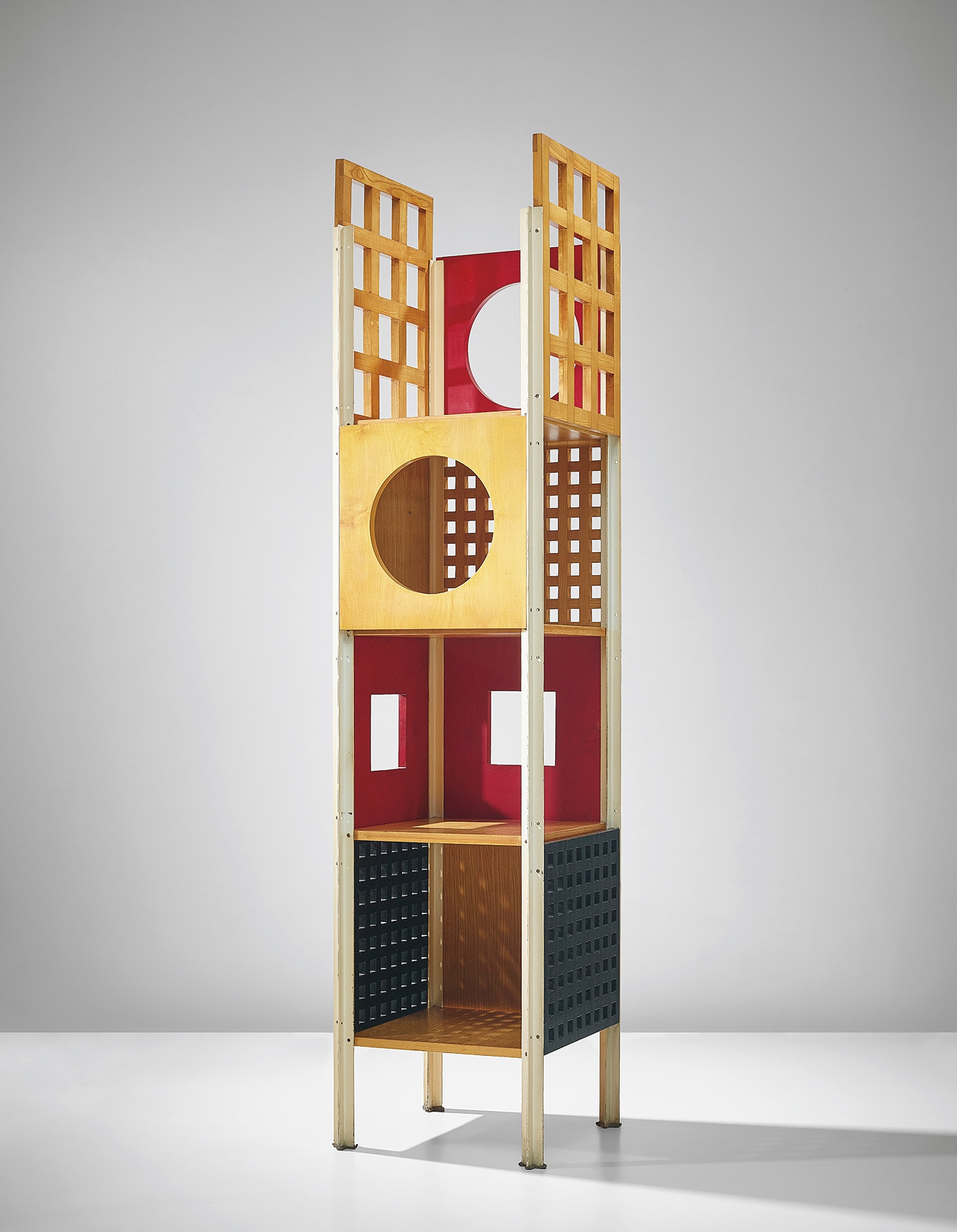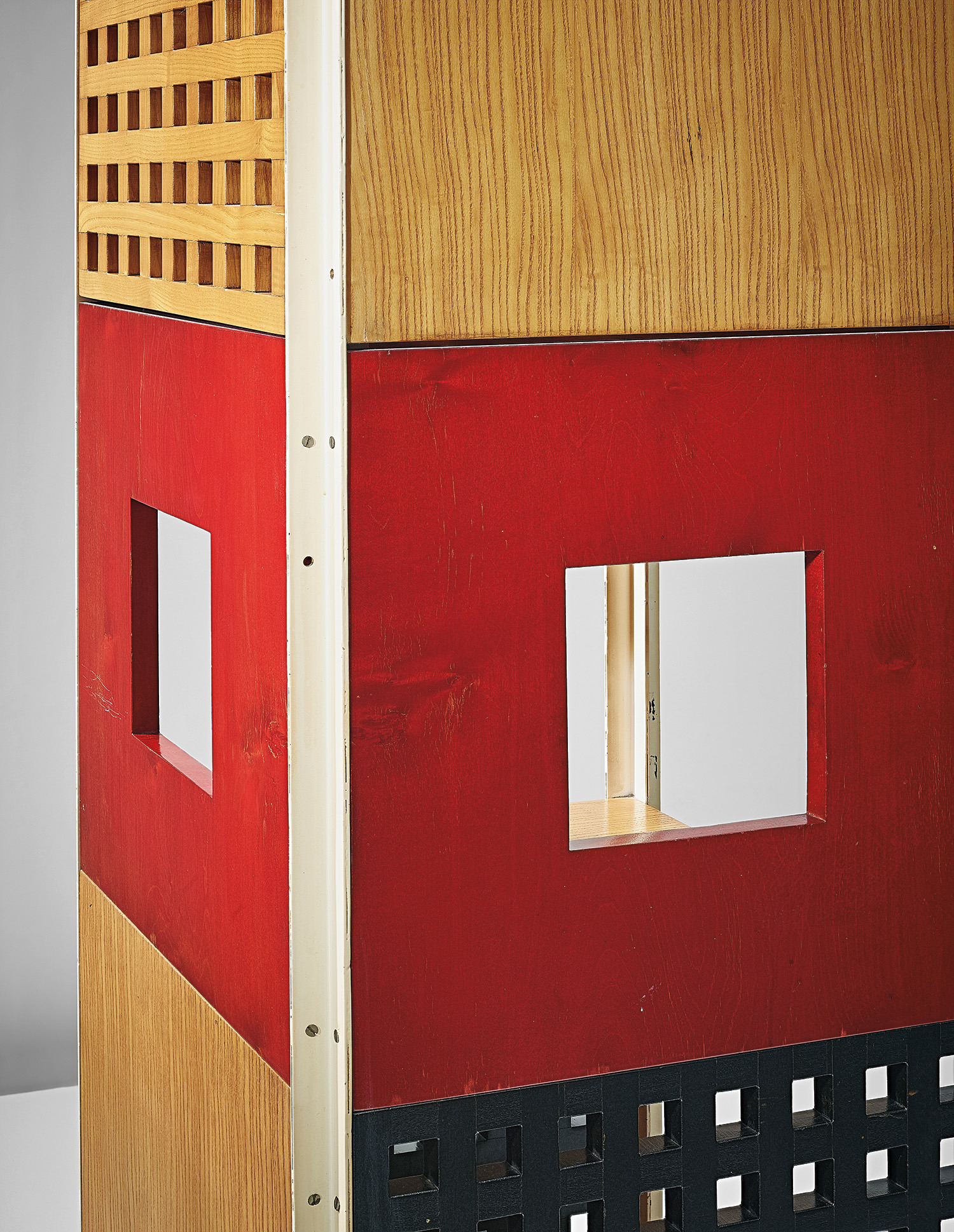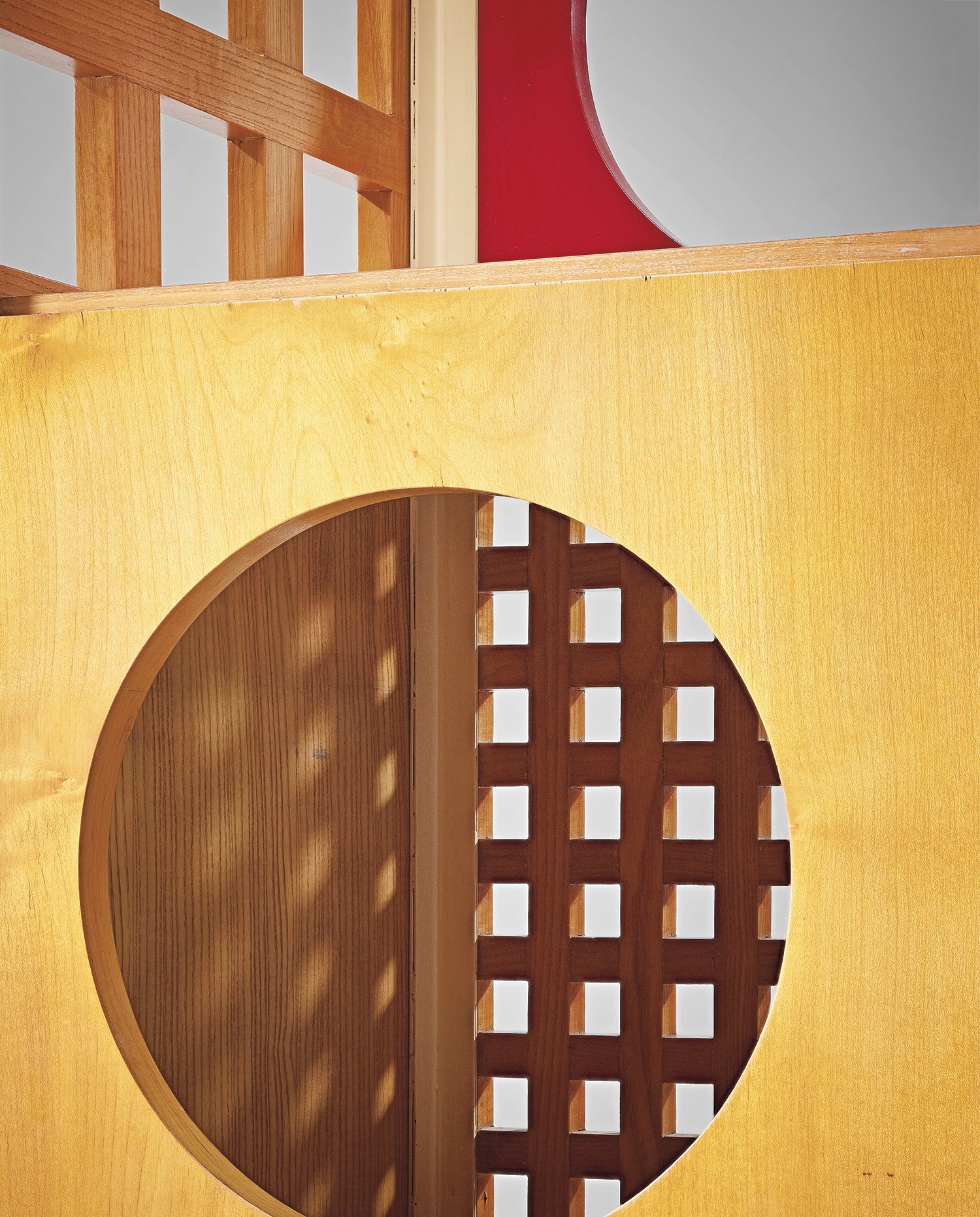







Property from the Collection of Renzo Brugola
118Ο◆
Ettore Sottsass, Jr.
Prototype 'Commode column'
circa 1963
Oak-veneered wood, oak, maple-veneered wood, painted maple-veneered wood, painted wood, painted steel.
218.2 x 50 x 50.2 cm (85 7/8 x 19 5/8 x 19 3/4 in.)
Executed by Renzo Brugola, Lissone, Italy. Together with original early preparatory sketch.
Full-Cataloguing
Renzo and Ettore
From my memory, the relationship between Ettore Sottsass Jr. and my father had always existed. Ettorino was considered as part of the family, and as with the other members of my family, I took his presence for granted. So now I find it difficult to recall when and how the two met each other. It is certain, however, that my father embraced the Milanese movida during the post-war period, which was an effervescent moment filled with ideas about the possibility of building a new future. During this period, my father frequented the bar Jamaica in Brera, Milan, where he gathered with workers, artisans, journalists, intellectuals and artists, some of whom would write the history of post-war art. Despite their many different backgrounds, they would all sit together around a table playing cards and discussing anything and everything. It was in this context that my father and Sottsass met.
Their friendship expanded to their families. I remember being told stories of evenings spent in Ettore and Nanda's (Fernanda Pivano) house, along with writers, artists, and engineers (Ettore was working for Olivetti at that time, developing the prototype for their typewriter). I also remember parties they had in my father’s workshop, his second home, which was conceived by Ettore as an open space with a central skylight and load-bearing perimeter walls. The world of Sottsass fascinated my father, who saw it as an opportunity to experience the world outside of Lissone.
While growing up in the 1970s, I remember occasional stories related to my father and Sottsass’ professional and personal association, but without any particularly defining moments, until the day my father came home with a new project: Memphis. My mother was terrified because following a challenging period, our circumstances had begun to improve and so, the idea of my father becoming involved in a new, uncertain project, in order to fulfill his own creative pursuits… In short, it was a difficult decision for my family.
However, Renzo, my father, perhaps fascinated by Ettore or by the possibility of creating new types of furniture, or simply because he understood the uniqueness of the project, began this new adventure. In 1981 he became one of the four founding members of Memphis. From that period, I remember the meetings in my father’s workshop with the youngsters of the studio Sottsass Associati (which included designers such as Michele De Lucchi and Aldo Cibic), discussing their project. Such conversations often involved the practicalities of realising their highly imaginative designs (‘it is beautiful, but it doesn’t stand’). I also remember Barbara's visits and the first Memphis collection (there was not a 'traditional' piece of furniture, all coloured, strange, unconventional).
When I told my father that I would like to have some of the pieces exhibited, his face brightened into a smile. The idea that his son, an engineer, appreciated this furniture and therefore the decision he had once made with Ettore, was of great satisfaction for him.
The relationship between Ettore and my father was revived. Part of the same vision, they were changing the shape of furniture and leaving an enduring mark in the world of design. Following Memphis, Ettore and my father continued to collaborate on other commissions and their bond never stopped growing. My father never missed an exhibition opening of Sottsass’ work and, when possible, he always wanted to realise Ettore's projects.
The loss of Ettore was immensely painful for my father. Their ages had advanced and now his friend of so many adventures was gone. Ettore remained in my father’s heart until his last days, he never stopped remembering, commemorating and enhancing his skills as an artist, unique of his kind. It was a beautiful friendship.
Barnabò Brugola
Ettore Sottsass Jr. - The Tower Furniture
The idea of the multifunctional tower furniture first appeared in Ettore Sottsass Jr.’s work in the early sixties. He introduced the design into his interiors for Casa Tchou, Milan in 1960 and subsequently developed it for ‘La casa abitata’, an exhibition held in Palazzo Strozzi, Florence in March 1965. For the exhibition, which was financed by Poltronova, Sottsass designed a domestic interior comprising two tall wooden towers framing a bed in the centre of the room. These two towers featured related formal characteristics to the present model ‘Commode column’, namely their composite shelving and multi-coloured grid frames.
Among the most notable of Sottsass’ designs of the sixties, these works illustrate the considerable contribution of Renzo Brugola, whose carpentry workshop was based in Lissone, near Milan. The collaboration between the designer and the carpenter continued to develop for over forty years and together they realised a significant number of prototypes and furnishings.
The tower furniture, continually enriched with new forms and meanings, became Sottsass’ preferred vehicle to communicate the evolution of his thoughts and the resulting design language. The iconic, totemic piece, conceived by Sottsass as a mysterious domestic deity, would characterise both his current and future work, beginning with Poltronova and continuing through his collaboration with Alchimia and Memphis in the 1970s and 1980s. Such works would eventually become part of the most important galleries and museum worldwide including the Metropolitan Museum of Art, New York and the Centre Georges Pompidou, Paris.
Arch. Milco Carboni
From my memory, the relationship between Ettore Sottsass Jr. and my father had always existed. Ettorino was considered as part of the family, and as with the other members of my family, I took his presence for granted. So now I find it difficult to recall when and how the two met each other. It is certain, however, that my father embraced the Milanese movida during the post-war period, which was an effervescent moment filled with ideas about the possibility of building a new future. During this period, my father frequented the bar Jamaica in Brera, Milan, where he gathered with workers, artisans, journalists, intellectuals and artists, some of whom would write the history of post-war art. Despite their many different backgrounds, they would all sit together around a table playing cards and discussing anything and everything. It was in this context that my father and Sottsass met.
Their friendship expanded to their families. I remember being told stories of evenings spent in Ettore and Nanda's (Fernanda Pivano) house, along with writers, artists, and engineers (Ettore was working for Olivetti at that time, developing the prototype for their typewriter). I also remember parties they had in my father’s workshop, his second home, which was conceived by Ettore as an open space with a central skylight and load-bearing perimeter walls. The world of Sottsass fascinated my father, who saw it as an opportunity to experience the world outside of Lissone.
While growing up in the 1970s, I remember occasional stories related to my father and Sottsass’ professional and personal association, but without any particularly defining moments, until the day my father came home with a new project: Memphis. My mother was terrified because following a challenging period, our circumstances had begun to improve and so, the idea of my father becoming involved in a new, uncertain project, in order to fulfill his own creative pursuits… In short, it was a difficult decision for my family.
However, Renzo, my father, perhaps fascinated by Ettore or by the possibility of creating new types of furniture, or simply because he understood the uniqueness of the project, began this new adventure. In 1981 he became one of the four founding members of Memphis. From that period, I remember the meetings in my father’s workshop with the youngsters of the studio Sottsass Associati (which included designers such as Michele De Lucchi and Aldo Cibic), discussing their project. Such conversations often involved the practicalities of realising their highly imaginative designs (‘it is beautiful, but it doesn’t stand’). I also remember Barbara's visits and the first Memphis collection (there was not a 'traditional' piece of furniture, all coloured, strange, unconventional).
When I told my father that I would like to have some of the pieces exhibited, his face brightened into a smile. The idea that his son, an engineer, appreciated this furniture and therefore the decision he had once made with Ettore, was of great satisfaction for him.
The relationship between Ettore and my father was revived. Part of the same vision, they were changing the shape of furniture and leaving an enduring mark in the world of design. Following Memphis, Ettore and my father continued to collaborate on other commissions and their bond never stopped growing. My father never missed an exhibition opening of Sottsass’ work and, when possible, he always wanted to realise Ettore's projects.
The loss of Ettore was immensely painful for my father. Their ages had advanced and now his friend of so many adventures was gone. Ettore remained in my father’s heart until his last days, he never stopped remembering, commemorating and enhancing his skills as an artist, unique of his kind. It was a beautiful friendship.
Barnabò Brugola
Ettore Sottsass Jr. - The Tower Furniture
The idea of the multifunctional tower furniture first appeared in Ettore Sottsass Jr.’s work in the early sixties. He introduced the design into his interiors for Casa Tchou, Milan in 1960 and subsequently developed it for ‘La casa abitata’, an exhibition held in Palazzo Strozzi, Florence in March 1965. For the exhibition, which was financed by Poltronova, Sottsass designed a domestic interior comprising two tall wooden towers framing a bed in the centre of the room. These two towers featured related formal characteristics to the present model ‘Commode column’, namely their composite shelving and multi-coloured grid frames.
Among the most notable of Sottsass’ designs of the sixties, these works illustrate the considerable contribution of Renzo Brugola, whose carpentry workshop was based in Lissone, near Milan. The collaboration between the designer and the carpenter continued to develop for over forty years and together they realised a significant number of prototypes and furnishings.
The tower furniture, continually enriched with new forms and meanings, became Sottsass’ preferred vehicle to communicate the evolution of his thoughts and the resulting design language. The iconic, totemic piece, conceived by Sottsass as a mysterious domestic deity, would characterise both his current and future work, beginning with Poltronova and continuing through his collaboration with Alchimia and Memphis in the 1970s and 1980s. Such works would eventually become part of the most important galleries and museum worldwide including the Metropolitan Museum of Art, New York and the Centre Georges Pompidou, Paris.
Arch. Milco Carboni